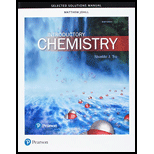
Concept explainers
Data Interpretation and Analysis
We can use
concentration and the
When using an electrochemical cell for this purpose, chemists often make voltage measurement of several
|
|
Voltage (V) |
| 0.100 | 0.310 |
| 0.200 | 0.319 |
| 0.300 | 0.325 |
| 0.400 | 0.328 |
| 0.500 | 0.331 |
| 0.700 | 0.335 |
| 1.00 | 0.340 |
a. Construct a graph of the measured voltage versus the log of the copper concentration. Is the graph linear?
b. Determine the slope and
-intercept of the best fitting line to the points in your graph from part a.
c. The voltage of two unknown solutions are measured and recorded. Use the slope and intercept from part b, together with the equation,
| Unknown
|
Voltage (V) |
| i | 0.303 |
| ii | 0.338 |
Want to see the full answer?
Check out a sample textbook solution
Chapter 16 Solutions
Introductory Chemistry-Selected Solution Manual
- The half cells Sn2+(aq) |Sn(s) and Cl2(g) |Cl(aq) are linked to create a voltaic cell. (a) Write equations for the oxidation and reduction half-reactions and for the overall (cell) reaction. (b) Which half-reaction occurs in the anode compartment, and which occurs in the cathode compartment? (c) Complete the following sentences: Electrons in the external circuit flow from the ______ electrode to the ____ electrode. Negative ions move in the salt bridge from the _____ half-cell to the _____ half-cell.arrow_forwardIdentify each statement as true or false. Rewrite each false statement to make it true. (a) Oxidation always occurs at the anode of an electrochemical cell. (b) The anode of a discharging voltaic cell is the site ofreduction and is negative. (c) Standard-state conditions for electrochemical cells are aconcentration of 1.0 M for dissolved species and a pressure of 1 bar for gases. (d) The potential of a voltaic cell does not change withtemperature. (e) All product-favored oxidation-reduction reactions have astandard cell potential Ecell, with a negative sign.arrow_forwardIt took 150. s for a current of 1.25 A to plate out 0.109 g of a metal from a solution containing its cations. Show that it is not possible for the cations to have a charge of 1+.arrow_forward
 Chemistry: The Molecular ScienceChemistryISBN:9781285199047Author:John W. Moore, Conrad L. StanitskiPublisher:Cengage Learning
Chemistry: The Molecular ScienceChemistryISBN:9781285199047Author:John W. Moore, Conrad L. StanitskiPublisher:Cengage Learning Chemistry & Chemical ReactivityChemistryISBN:9781337399074Author:John C. Kotz, Paul M. Treichel, John Townsend, David TreichelPublisher:Cengage Learning
Chemistry & Chemical ReactivityChemistryISBN:9781337399074Author:John C. Kotz, Paul M. Treichel, John Townsend, David TreichelPublisher:Cengage Learning Chemistry & Chemical ReactivityChemistryISBN:9781133949640Author:John C. Kotz, Paul M. Treichel, John Townsend, David TreichelPublisher:Cengage Learning
Chemistry & Chemical ReactivityChemistryISBN:9781133949640Author:John C. Kotz, Paul M. Treichel, John Townsend, David TreichelPublisher:Cengage Learning ChemistryChemistryISBN:9781305957404Author:Steven S. Zumdahl, Susan A. Zumdahl, Donald J. DeCostePublisher:Cengage Learning
ChemistryChemistryISBN:9781305957404Author:Steven S. Zumdahl, Susan A. Zumdahl, Donald J. DeCostePublisher:Cengage Learning Chemistry: An Atoms First ApproachChemistryISBN:9781305079243Author:Steven S. Zumdahl, Susan A. ZumdahlPublisher:Cengage Learning
Chemistry: An Atoms First ApproachChemistryISBN:9781305079243Author:Steven S. Zumdahl, Susan A. ZumdahlPublisher:Cengage Learning





